Energy Game: calories or something else?
Posted: 2007-January-16 Filed under: Energy Game | Tags: calorie, candy, energy, food, LED Leave a comment »Jolly Jill asked about making a "universally recognized unit of 'energy consumed'" rather than the Calorie — something like a battery or a gas-can or an apple. Here's my e-mail response:
I took a closer look a this and tried to make some kind of "energy currency." It is valuable to keep things at a human-level, so a 100-Calorie apple seems to be a good choice. A 2.75-inch apple has about 100 calories. Conveniently enough, a peck contains about 25 of these size apples and a bushel, about 100.
For a smaller unit, a grape has about 3.4 calories (about 4 watt-hours) so 30 grapes (or maybe 5 6-grape bunches) makes one apple. For purposes of LED's, though, we're talking about 0.05 Calories or about 1/66th grapes. Thus, an even smaller unit could be a drop of maple syrup. There's 200 calories in a 4-tablespoon serving (so that's 16 Calories per teaspoon) and I put a little more than 12 drops into a 1/4 teaspoon, so each drop is about 1/3 Calorie (0.4 watt-hours); 10 drops makes a grape.
A candy sprinkle is about 0.07 inches across so about 877 fit in a teaspoon making each of them (assuming they're made entirely from sugar) about 0.018 Calories each so there's 18 in a drop of syrup. Let's call it 20 sprinkles, so 960 would fit in a teaspoon and each is 1/60 Calories. So now we've got:
- 1 sprinkle = 1/60 Calories
- 20 sprinkles = 1 drop of maple syrup = 1/3 Calorie
- 10 drops maple syrup = 1 grape = 3.4 Calories
- 6 grapes = 1 bunch of grapes = 20 Calories
- 5 bunches of grapes = 1 apple = 100 Calories
- 25 apples = 1 peck of apples = 2500 Calories
- 100 apples = 1 bushel of apples = 10000 Calories
I'm afraid I'm going in the wrong direction with this. Although it's neat to see the conversions, I think it makes things _less_ intuitive — calorie numbers may be best because they're compact to represent. This may be a useful way to get people to think about calories, though … like an LED can run for an hour on the energy in 3 candy sprinkles, or that it takes 3 bushels of apples to match the energy in a gallon of gas.
![]()
Energy Game: e-mailing the original idea
Posted: 2006-December-15 Filed under: Energy Game | Tags: calorie, efficiency, electricity, gasoline, generator, killowatt-hour, kilocalorie, watt-hour Leave a comment »The initial e-mail was as follows:
To help people manage their energy choices, I'd like to make the radical suggestion that you look at everything you bring simply for its energy content. Well, let's say limited to the devices that generate or convert energy forms, fuel, and things to burn. Including the food for people.
The key is to examine the energy with some common unit (although the sources of energy would be put in separate tables.) I want it to be the Calorie (with a big "C"; kilocalorie, that is … the one we use for food.) Obviously, then, all your food will be broken down into a list of the total calories. Gasoline, for instance, at 36.5 kilowatt-hours per gallon works out to an equivalent of 31,400 Calories per gallon (that's almost 16 days at 2,000 Calories per day, in case you're curious.)
For devices that take energy as input (i.e. gasoline in a generator) and produce energy as output (i.e. electricity from a generator) then you'd note it on the "source" energy table as a thing that consumes (i.e. a loss) and a supply of energy (i.e. a gain) on the "destination" energy table. For something like a solar panel, it would simply produce energy without consuming any — although it is from sunlight, you don't carry the sunlight in with you (despite the neat metaphor.) Consumers of energy would just show up as negatives (i.e. light bulbs would consume electrical energy; people would consume food.)
So a really basic set of tables for a camp of 10 people for 6 days who want to bring a 5KW generator, 5 gallons of gas, and a 100-watt string of lights they intend to run for 6 hours each day, it would look like this:
Food
----
+120,000 Amount of food to bring
-120,000 10 people consuming 2,000 Calories a day for 6 days consume 120,000 Calories.
--------
0
Gasoline
--------
+157,000 5 gallons of gas
- 52,000 Energy used by the generator to run the lights (see note below.)
-105,000 Take home 3.1 gallons of gas
--------
0
Electricity
-----------
+3,100 Energy produced by the generator to run the lights (see note below.)
-3,100 100 watts * 6 hours per day * 6 days
------
0
(A note about the generator efficiency: a not-too-unusual 5500 watt generator I found on the Internet consumes 0.63 gallons/hour at peak efficiency of 50% capacity (2750 watts). Simply scaling that linearly would mean that 100 watts would consume 0.023 gallons/hour or about 720 Calories-per-hour and produce 86 Calories-per-hour. However, a gasoline engine's efficiency falls sharply when it's not being run at ideal power, so I'm guessing the efficiency would be twice as bad, thus, for the same 100 watts, it's 0.046 gallons/hour or about 1440 Calories-per-hour. Multiplying that out for the 6 days at 6 hours a day and it's 51,840 Calories.)
[Anyway, this camp chose their generator quite poorly and they probably wouldn't have, but I'm just using it as an example. It took me a while to piece the numbers together, but all these conversions can be provided in a table.]
Now the trick is to make it less like doing U.S. Income Taxes and more like fun. I talked with my friend Sondra Carr about it and she suggested one of those slide-rule kind of wheels to do conversions because she finds them more fun that filling out forms. I had suggested units of "loaves of bread" or something and she liked that — especially if this could all be coupled with a camp where you'd make a solar-baked loaf of bread, and while it's baking, to learn about how to do this analysis and to get a slide-rule wheel with the pertinent information.
Anyway, what's the education about it? My goal is to make it like the "remove packaging before you leave so you don't have to carry so much trash home" kind of elegance. I like that statement because it makes perfect sense and if you follow it, you go "wow: why is there all this friggin' packaging?" as you look at the pile in your living room when you've gone through all your convenience foods. It doesn't judge or condemn or make more work to make you learn something.
This is what I like about this:
- I think it can be made into a useful tool to help analyze a camp's energy usage. It's one of those things that gets overlooked in the planning process. How many of us have heard, "I don't know … just grab a 1,000 watt generator and bring like 20 gallons of gas and we should be all set."
- I think Calories put it into a human perspective: I had never done the conversion, but to think that the energy in a gallon of gas is the same amount of energy the average person needs for two weeks … wow.
- I think it shows how inefficient generators are and helps to identify where your energy goes. There is probably more work to be done here — I had originally wanted to do one big table so I could show waste (i.e. 52,000 Calories of gas becomes 3,100 Calories of electricity so 95% of the energy in the gas is wasted) but it was too cumbersome to present.
- I think it gives people a tangible idea of what energy is and where it goes. There is probably more work to be done here … I mean making it more concrete — make apples the unit (so a gallon of gas would be equivalent to about 350 apples) or bread … I like bread because it's so rooted in cultural traditions.
![]()
New back wheels
Posted: 2006-June-5 Filed under: Frame, Projects, The Bike With 2 Brains Leave a comment »I'd like to bring the Bike With 2 Brains back to Burning Man this year so I've been thinking about replacing the back wheels with ones that wouldn't break so easily. My dad gave me a couple 9" heavy-duty equipment casters so I figured I'd use them. I had originally thought to use larger ones, but free wins.
I tinkered around with the copper model a little to see what would look least stupid — 24" front wheels and 9" back wheels will probably look pretty silly. I decided to maintain the existing frame design as best I could (i.e. least amount of work to change) and just extend a leg with a decorative (and suspension-flex) bend in it and weld it to a plate, bolted to the caster. I had the plates from straight wheels I bought for my bicycle trailer, so I canabalized them for the project. I bent a piece of 1" water pipe then cut it so the bottom was perpendicular to the straight part of the pipe on top which gets welded to the old steering tube used with the original back wheels. It looks like the back end will ride a little higher with the new wheels, but not by much.
![]()
Strengthen screw holes using a twist-tie.
Posted: 2005-December-24 Filed under: Wood Leave a comment »Remove the loose screw, bend a twist-tie in half, and stick the bend corner into the hole. Cut it off with scissors, leaving a hole's-width sticking out. Bend the two protruding ends opposite one another, flush to the surface. Screw the screw in again — the thickness of the twist-tie will help keep the screw from pulling out.
![]()
Before putting your hands on bare wires, short them out first.
Posted: 2005-December-24 Filed under: Electrical Leave a comment »When you work on any in-wall electric circuits, shut off the power at the breaker. When you're absolutely sure the power is off, short out the wires using a screwdriver. If you have done everything correctly, nothing will happen; otherwise, a shower of sparks will indicate your error rather than you being electrocuted.
![]()
When working on an appliance, put the plug in your pocket.
Posted: 2005-December-24 Filed under: Electrical Leave a comment »Make a habit of putting the plug of any appliance you're working on into your pocket. That way, you'll be less likely to accidentally work on it when it's plugged in.
![]()
Wipe toilet seats with a small amount of toilet paper.
Posted: 2005-December-24 Filed under: General Leave a comment »If you need to use any "unfamiliar" toilet (public or just at a someone's house) make a habit of grabbing a couple sheets of toilet paper first and wiping down the seat. That way you'll never sit on a wet seat and you'll know in advance that there is toilet paper.
![]()
Use used coffee grounds to wash grease from your hands.
Posted: 2005-December-24 Filed under: Cleaning Leave a comment »Wash your hands with a mixture of a small pinch of used coffee grounds with ordinary dish soap to remove grease.
![]()
The Burning Man exhibition
Posted: 2005-August-29 Filed under: Exhibitions, Projects, The Bike With 2 Brains Leave a comment »I arrived at Burning Man (The Man, Black Rock City, NV) on Sunday, August 28. I got there pretty late in the afternoon so I had to hustle to just get camp set up before dark. I started assembling the frame on Monday morning. As I have done a dozen times prior, I start with the wheels and lower frame upside-down then I flip it over. However, this time, the frame snapped in half — on the left side and right side of the seat where the stress is greatest.
Ironically, I even quipped back in May "I used the pipe from my friend's house on Burkhard Place — it was the original water pipe that was installed 110 years ago … so if it breaks sometime in the future, that might be why." It was actualy the threaded part that broke … the threads made the walls of the tubing thinner and finally gave way.
Someone (I think his name was Cram) suggested Black Rock Hardware camp to see if they had a welder, but they didn't. However on Sunday evening I met people at Recycle Camp and they did. I talked with Angry Butterfly who said she'd probably have a free moment on Tuesday morning and took pity and/or sent me searching for energy drinks and cheeseburgers for her. I went back to Hardware and ground off the paint and made pipe inserts to further strengthen the joint.
Tuesday morning (my birthday) I took the frame parts to Recycle Camp and hung out with the crew a while. Angry Butterfly had to repair their can crusher so I helped with that and then she got my stuff welded.
I got back to my camp and assembled the project. I put in a fresh battery and flipped it on and … nothing. The computer wasn't running. I did some testing and realized the power supply spikes above 5 volts initially and it seemed to be latching up the computer which has an "Absolute Maximum" voltage of 5.5 volts. Wiggling the wires got it booted up and running, though.
I pushed it out to The Artery, signed in, and had now officially completed (almost) everything for the grant requirement. I pushed it out to Lost Penguin which is a chill-space with couches and such where they give away chocolates and wine. While I was sitting there, only one guy stopped to even look at the project.
I headed back to where I left it later but it was gone. I couldn't see it anywhere around on the horizon so I went back camp and found that "Ben and Babz" brought it back, leaving a note in the dust on my car. A couple other people tried it out and in the process seemed to loosen one of the wires. The computer stopped working again and I couldn't get it to do anything. So, in the last two hours of sunlight, I pulled all the existing chips and threw in a simple circuit to get all the blue lights to go on when it's dark.
My neighbor Troy and I figured out how to slowly ride it forward and took it about 3 miles to Alien Semaphore and left it there.
Wednesday morning I got up and started a hunt for the project. I went way out to the north trash fence and headed back … no luck. On Thursday I got up and did the same thing. I was getting a little alarmed when I couldn't find it — I prepared myself to let it go, but I kind of thought I'd see it way off in the distance maybe once a day … or at least have someone I know tell me they saw it, but no word at all. Friday morning was a repeat … another unsuccessful hunt. By Saturday I was getting quite worried. I never found my project at all and I started feeling trapped — after all, I'm responsible for removing it, so I'll have to stay forever until everything is gone.
Sunday I got up before sunrise. I felt a bit numbed to the idea of hunting for the project again, but I decided to systematically scour the city. I started at 6:00 and Hysteria — the furthest street — and rode from there to 2:00 and Hysteria. I then returned on Gestalt, back out on Fetish, then Ego, Delerium, Catharsis, Bipolar, and Amnesia … in all nearly 11 miles. No project found. I took a brief break then started on the other half of the city … 6:00 and Hysteria to 10:00, then back on Gestalt and … found!
It was around Gestalt and 9:00 — pretty much as far away from my camp as you can get and still be inside the city. One of the forks broke and a tire had blown out in the back. It had been cobbled and patched — the tensioner spring on the generator had been replaced with some wire and a condom and the tire had been patched a bit with duct tape.
I met this guy Gabriel who was somewhat incoherent … he apparently was awake at least all night and might still have been drunk. Their camp (or neighborhood) had adopted it and called it the "Space Car." They said they had tons of fun on it … he said that "sometimes it would make noise and we thought it was sad so we'd ride it some more." Someone else who was packing up and leaving thought it appeared sometime around Friday in its broken state but couldn't be sure.
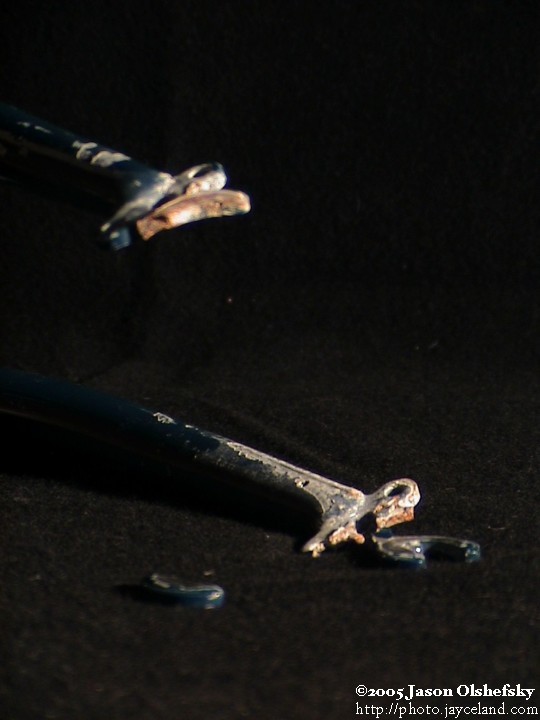
The forces really ripped the fork apart, though — I expected that some part on the back would fail, I just didn't know which.
I biked back, grabbed some tools and the spare fork and went back to get it. I fixed the broken bits enough to be able to move it. I actually towed it with a strap to my bike. I stopped by Borrachos y bicicletas but they had no spare 24" tubes, but they suggested I just take the tires and tubes off the back wheels and ride it on the rims. I did that and managed to get the MP3 player started again so I took it to Kidsville so the kids there could play on it.
I locked it up that night so I wouldn't have to worry about it.
Monday, September 5 I got up early and started slowly packing. I got the project taken apart and managed to fit everything back in the car again and headed back home.
![]()
Just a picture of the sound board
Posted: 2005-August-21 Filed under: Audio, Projects, The Bike With 2 Brains Leave a comment » ![]()

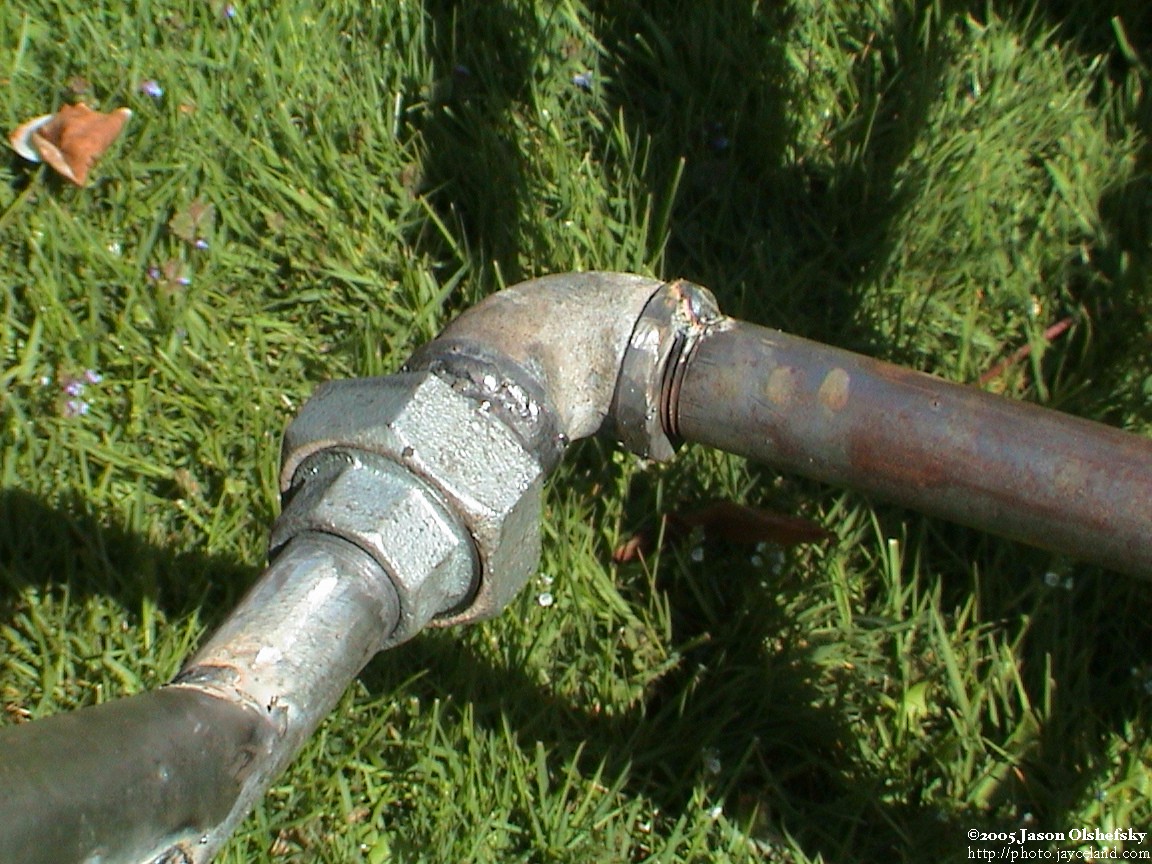
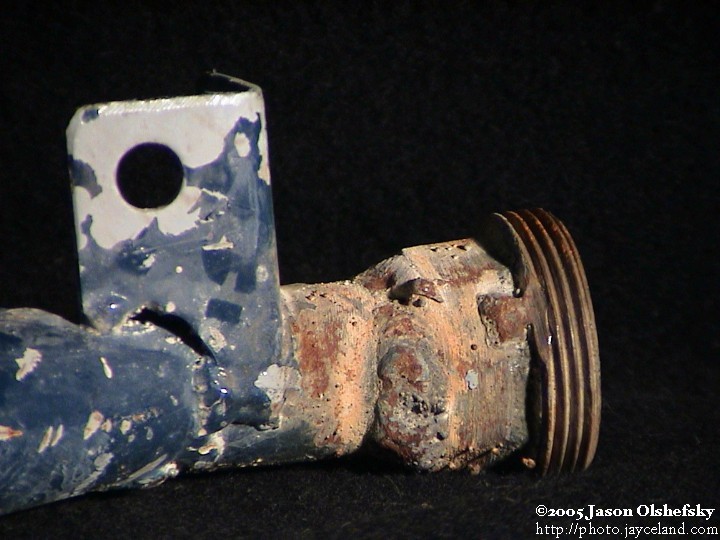
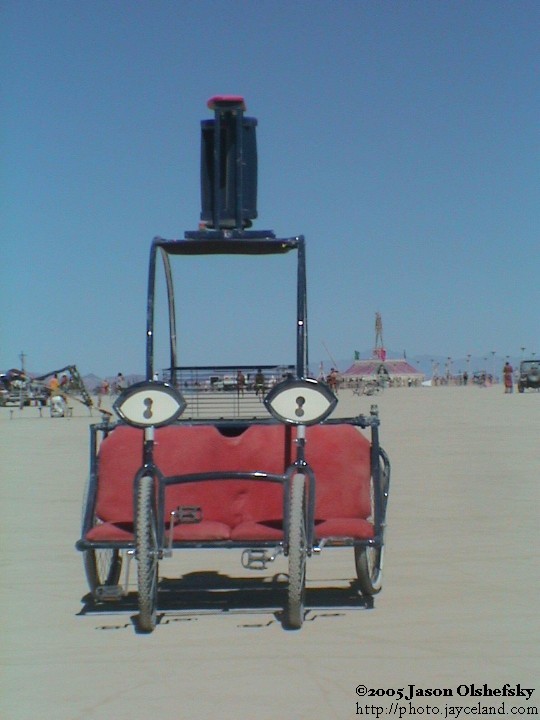
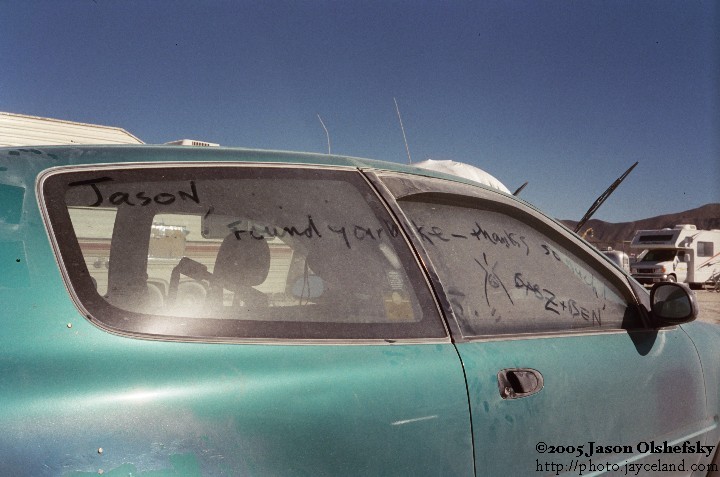
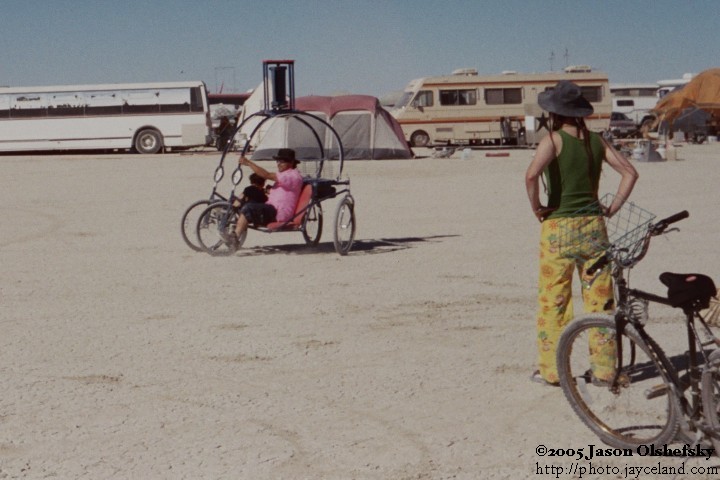

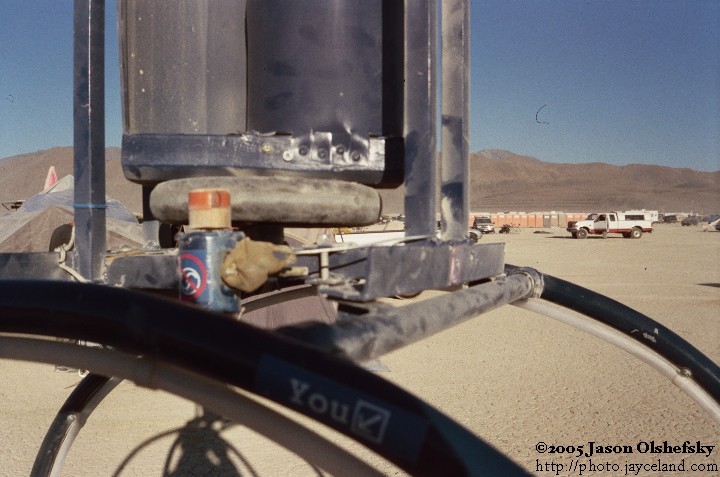


Recent Comments